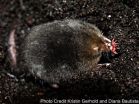(Press-News.org) What came first: the bipedal human ancestor or the grassland encroaching on the forest?
A new analysis of the past 12 million years' of vegetation change in the cradle of humanity is challenging long-held beliefs about the world in which our ancestors took shape – and, by extension, the impact it had on them.
The research combines sediment core studies of the waxy molecules from plant leaves with pollen analysis, yielding data of unprecedented scope and detail on what types of vegetation dominated the landscape surrounding the African Rift Valley (including present-day Kenya, Somalia and Ethiopia), where early hominin fossils trace the history of human evolution.
"It is the combination of evidence both molecular and pollen evidence that allows us to say just how long we've seen Serengeti-type open grasslands," said Sarah J. Feakins, assistant professor of Earth sciences at the USC Dornsife College of Letters, Arts and Sciences and lead author of the study, which was published online in Geology on Jan. 17.
Feakins worked with USC graduate student Hannah M. Liddy, USC undergraduate student Alexa Sieracki, Naomi E. Levin of Johns Hopkins University, Timothy I. Eglinton of the Eidgenössische Technische Hochschule and Raymonde Bonnefille of the Université d'Aix-Marseille.
The role that the environment played in the evolution of hominins—the tribe of human and ape ancestors whose family tree split from the ancestors of chimpanzees and bonobos about 6 million years ago—has been the subject of a century-long debate.
Among other things, one theory dating back to 1925 posits that early human ancestors developed bipedalism as a response to savannas encroaching on shrinking forests in northeast Africa. With fewer trees to swing from, human ancestors began walking to get around.
While the shift to bipedalism appears to have occurred somewhere between 6 and 4 million years ago, Feakins' study finds that thick rainforests had already disappeared by that point—replaced by grasslands and seasonally dry forests some time before 12 million years ago.
In addition, the tropical C4-type grasses and shrubs of the modern African savannah began to dominate the landscape earlier than thought, replacing C3-type grasses that were better suited to a wetter environment. (The classification of C4 versus C3 refers to the manner of photosynthesis each type of plant utilizes.)
While earlier studies on vegetation change through this period relied on the analysis of individual sites throughout the Rift Valley—offering narrow snapshots—Feakins took a look at the whole picture by using a sediment core taken in the Gulf of Aden, where winds funnel and deposit sediment from the entire region. She then cross-referenced her findings with Levin who compiled data from ancient soil samples collected throughout eastern Africa.
"The combination of marine and terrestrial data enable us to link the environmental record at specific fossil sites to regional ecological and climate change," Levin said.
In addition to informing scientists about the environment that our ancestors took shape in, Feakins' study provides insights into the landscape that herbivores (horses, hippos and antelopes) grazed, as well as how plants across the landscape reacted to periods of global and regional environmental change.
"The types of grasses appear to be sensitive to global carbon dioxide levels," said Liddy, who is currently working to refine the data pertaining to the Pliocene, to provide an even clearer picture of a period that experienced similar atmospheric carbon dioxide levels to present day. "There might be lessons in here for the future viability of our C4-grain crops," says Feakins.
###
Funding for this research was provided by the U.S. National Science Foundation HOMINID Grant 0218511 and from USC. END
New Geology study raises questions about long-held theories of human evolution
2013-01-31
ELSE PRESS RELEASES FROM THIS DATE:
Joslin scientists find first human iPSC from patients with maturity onset diabetes of the young
2013-01-31
BOSTON – January 31, 2013 – Joslin scientists report the first generation of human induced pluripotent stem cells from patients with an uncommon form of diabetes, maturity onset diabetes of the young (MODY). These cells offer a powerful resource for studying the role of genetic factors in the development of MODY and testing potential treatments. The findings appear in the Journal of Biological Chemistry.
Human induced pluripotent stem cells (hiPSCs) are adult cells that have been genetically reprogrammed to exhibit the characteristics of embryonic stem cells, including ...
Personalized medicine eliminates need for drug in 2 children
2013-01-31
This press release is available in French.Using genome-wide analysis, investigators at the Sainte-Justine University Hospital Research Center and the University of Montreal have potentially eliminated a lifetime drug prescription that two children with a previously unknown type of adrenal insufficiency had been receiving for 14 years. Over a lifespan, the adjustment in treatment represents an approximate saving of $10,000 in drug and test costs per patient. Moreover, the less invasive treatment regime can potentially reduce the lifetime risk of hypertension in the patients. ...
Nanomaterials key to developing stronger artificial hearts
2013-01-31
On January 30, 2013 ACS Nano published a study by Ali Khademhosseini, PhD, MASc, Brigham and Women's Hospital Division of Biomedical Engineering, detailing the creation of innovative cardiac patches that utilize nanotechnology to enhance the conductivity of materials to induce cardiac tissue formation. Creation of these ultra-thin cardiac patches put medicine a step closer to durable, high-functioning artificial tissues that could be used to repair damaged hearts and other organs.
The cardiac tissue patches utilize a hydrogel scaffolding reinforced by nanomaterials called ...
Pediatric orthopaedic surgeons show age-related patterns of spine injury in ATV injuries
2013-01-31
Memphis, Tenn. – Children continue to account for a disproportionate percentage of morbidity and mortality from ATV-related accidents – up 240 percent since 1997, according to a Journal of Pediatric Orthopaedics report published by pediatric orthopaedic surgeons at Le Bonheur Children's Hospital.
The surgeons – who studied data from the Kids' Inpatient Database – found spine-related injuries from all-terrain vehicles (ATVs) in the United States are more common in older children and in females, unlike males in most trauma studies. ATV-related spine injuries in children ...
Researcher uncovers potential cause, biomarker for autism and proposes study to investigate theory
2013-01-31
NEW YORK, NY — A New York-based physician-researcher from Touro College of Osteopathic Medicine, best known for his research into fertility and twinning, has uncovered a potential connection between autism and a specific growth protein that could eventually be used as a way to predict an infant's propensity to later develop the disease. The protein, called insulin-like growth factor (IGF), is especially involved in the normal growth and development of babies' brain cells. Based on findings of prior published studies, Touro researcher Gary Steinman, MD, PhD, proposes that ...
Working alone won't get you good grades
2013-01-31
Students who work together and interact online are more likely to be successful in their college classes, according to a study published Jan. 30 in the journal Nature Scientific Reports and co-authored by Manuel Cebrian, a computer scientist at the Jacobs School of Engineering at the University of California San Diego.
Cebrian and colleagues analyzed 80,000 interactions between 290 students in a collaborative learning environment for college courses. The major finding was that a higher number of online interactions was usually an indicator of a higher score in the class. ...
Adding new members to group increases distrust among older members, impacts coordination
2013-01-31
Adding a new member to a working group can create distrust between members and hinder group functions, but a new study suggests that the distrust created is between older group members rather than about the newcomers- especially when previous group performance with just the older group members is poor. The results are part of a study published January 30 in the open access journal PLOS ONE by Matthew McCarter and Roman Sheremeta from Chapman University (U.S).
Previous studies report that changing members in an existing group hurts group performance, but the underlying ...
Leading by the nose: Star-nosed mole reveals how mammals perceive touch, pain
2013-01-31
The most sensitive patch of mammalian skin known to us isn't human but on the star-shaped tip of the star-nosed mole's snout. Researchers studying this organ have found that the star has a higher proportion of touch-sensitive nerve endings than pain receptors, according to a study published January 30 in the open access journal PLOS ONE by Diana Bautista and colleagues from the University of California, Berkeley and Vanderbilt University.
Touch and pain are closely intertwined sensations, but very little is known about how these sensations are detected in our cells. In ...
Chimp see, chimp learn: First evidence for chimps improving tool use techniques by watching others
2013-01-31
VIDEO:
This video shows the "dipping " technique performed by chimpanzee Ayumu. Note that he uses his mouth to insert the tube into the bottle. In form, his technique is identical to...
Click here for more information.
Chimps can learn more efficient ways to use a tool by watching what others do, according to research published January 30 in the open access journal PLOS ONE by Shinya Yamamoto and colleagues from Kyoto University and Kent University, UK. Their study ...
Tapeworm eggs discovered in 270 million year old fossil shark feces
2013-01-31
A cluster of tapeworm eggs discovered in 270-million-year-old fossilized shark feces suggests that intestinal parasites in vertebrates are much older than previously known, according to research published January 30 in the open access journal PLOS ONE by Paula Dentzien-Dias and colleagues from the Federal University of Rio Grande, Brazil.
Remains of such parasites in vertebrates from this era are rare- of 500 samples examined, only one revealed the tapeworm eggs. This particular discovery helps establish a timeline for the evolution of present-day parasitic tapeworms ...


